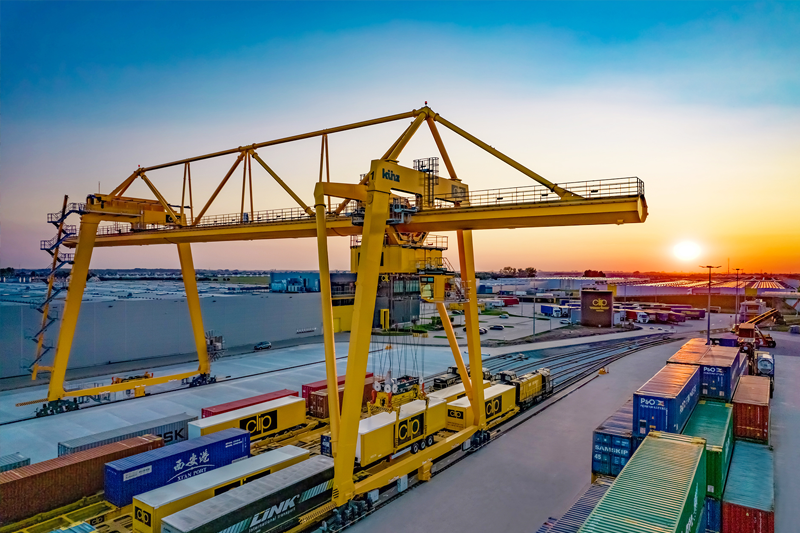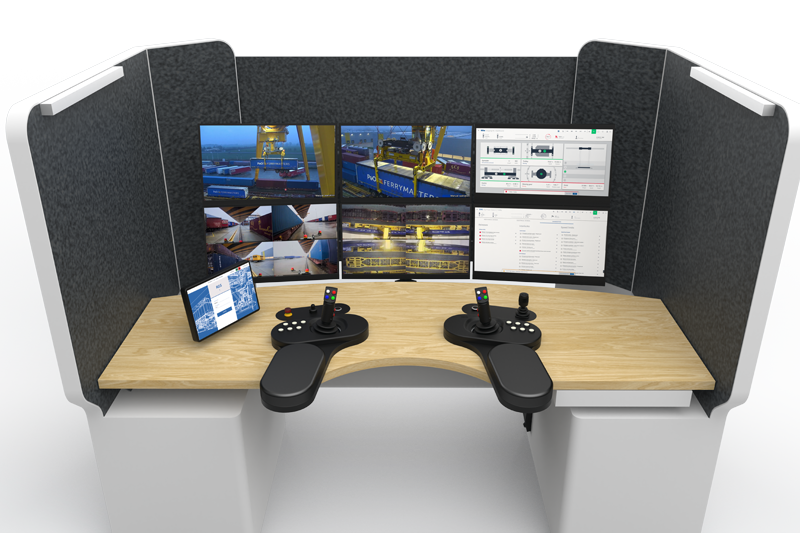Seaport-connection to the Alb-Danube Region
Mid-sized Denkinger forwarders setting up rail cargo terminal in Rottenacker ...

The crane moves as if by magic. The cabin is unmanned. No driver is visible anywhere and yet the crane glides backwards and forwards almost noiselessly, hoists containers and lowers them again. One of the specialists constructing such cranes is Künz. With more than 200 fully-automatic stacking cranes in operation worldwide, the company has great experience with automated container-handling in seaport terminals like Hamburg’s. This smoothed the way for efficient automation of several intermodal terminals in North America, of which the first only entered service at Winter Haven, Florida, in 2018. In the years that followed, Künz also succeeded in persuading terminal operators in Europe of the advantages of automating intermodal crane installations, with projects being successfully implemented in Germany, Italy, Luxembourg, Hungary, Norway and Poland - see photo.
Several courses of action are possible here. In planning new intermodal terminals, allowance can be made for all aspects of automation from the beginning. Yet the possibility also exists of introducing automated operation step by step at those terminals with existing manually operated cranes that are traditionally controlled from a cabin. Assistance systems already boost the efficiency and the safety of manual operation from the crane cabin. For example, the crane driver can be assisted by cameras that simplify picking up a container. Additional cameras, but also laser systems, scrutinize the area in front of the crane trolleys. In emergency, these trigger deceleration of the crane, should an object be located near the crane track.
As a next step, remote operation stations are either installed at the terminal, or included in planning right from the start. Here it would be right to speak of a total game-changer. The operator no longer needs to climb to the cabin on the crane, but has a workplace in an office-like environment. In parallel, it is essential that processes at the terminal are completely adapted to this. The TOS - Terminal Operating System must optimally plan for all the handling processes to be implemented by the crane equipment. The TOS commands are taken over by the operator and the crane moves itself across the relevant point of destination. The operator simply needs to supervise the move. Then the operator triggers the hoisting and lowering movements. A ‘soft-landing system’ developed by Künz causes such movements to be continued and terminated automatically. This simplifies operation and prevents hard, loud deposit of the containers.
„More than 200
fully automatic
stacking cranes
are in operation
worldwide"

The great diversity of freight units in intermodal terminals constitutes a significant difference as compared to seaport terminals. Along with containers, a variety of swap-bodies and cranable semi-trailers arrive there that can be accepted by the spreader’s grabs. Additional cameras on the grabs improve the view. Especially with grab handlin, it is essential to have all data available at a glance. In response to this challenge, Künz introduced a further innovation. On the one hand, the new visual overlay system enables such data as the current load weight or the positions and speed of all the moving devices on the crane to be seen directly on the camera’s video stream. On the other, lines and corners are dynamically superimposed that considerably simplify acceptance of the load units, and enhance safety in handling. Moreover, test comparisons in realistic conditions indicated a ten percent boost in throughput totals.
By contrast with seaport terminal stacking areas, people live at intermodal terminals. They include truckers and railcar inspectors and can be found in the area of crane units. To permit fully automatic crane operation, therefore, one vital condition needs to be met. Either use of boundary fences ensures that during fully automated operation no persons are present in the crane area; or technical solutions are implemented that continually compare the positions of all individuals plus all movable objects such as vehicles with the position of the crane, thus ensuring timely prevention of dangerous situations. This facilitates a boost for the degree of automation of pure container handling in intermodal terminals to the extent that crane units can fully automatically undertake handling in the stacking area, as well loading/discharge of trains and trucks.
Locations: Four in Austria – with headquarters at Hard, Vorarlberg Additional branches at Kenches, Slovakia; Padua, Italy; Vlaardingen, Netherlands; and Raleigh, USA
Workforce: approx. 550
Founded: 1932 in Hard, by Hans Künz
Fields of business: Innovative crane units with a degree of automation for container handling, the mining industry, handling of rails and timber, as well as screen cleaning machines for power supply companies. Künz is notable for providing complete coverage for all areas of business – from consultancy via planning, design and production to assembly, training and maintenance.